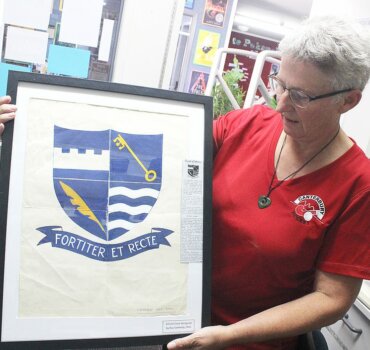
Glenys Bichan with Kay Connelly’s original design for Cambridge High School’s coat of arms.
If you knew Kay Connolly when she was a sixth form student at Cambridge High SchooI in 1966, then school library manager Glenys Bichan wants to hear from you.
Kay designed a new school coat of arms which won a competition 56 years ago and it is still in use today.

Cambridge High School caretaker Neil Ward with some of the books he found in the groundskeeper’s shed loft.
The original drawing was recently among a treasure trove found in the groundskeeper’s shed.
Caretaker Neil Ward, who has been at the school 16 years, cleaned out the loft and found boxes of old papers covered in dust and grime.
Ward knew instantly Bichan would want to know of the discovery. She is establishing the Marshall Archives, named after former principal George Marshall, as an extension to the school library.
In the boxes were photos of cadets from the 1940s, school examination results, diaries, newspaper articles, school and Parent Teacher Association minutes and Kay’s original coat of arms folded into four and in the middle of a box.
Within minutes Bichan had the coat of arms in a frame realising its historic significance and was chatting to Pam Woodhams nee Astwood, who attended the school from 1964-1966 and who now works as an administration support staffer there.
She found in the box a reference to her leaving school in March 1966 to start work at Cambridge Tyre Services.

Pam Eastwood, left, and Glenys Bichan pore through some of the items found in long-forgotten boxes.
“That’s absolutely right,” said Woodhams.
The two were rummaging through the boxes when The News visited chuckling with glee at the contents and the memories contained in them.
Bichan wants to track Kay down, show her the original coat of arms design and talk to her about it and why she chose the components.
In a newspaper article found with the drawing, it was reported Kay was the daughter of Mr and Mrs S.K. Connolly of King Street, Cambridge.
She was a former VA pupil who took art as a School Certificate subject.
The coat of arms is commonly called a crest but that is incorrect, according to the article.
The crest was originally a device worn on the helmet and was quite different from a coat of arms.

The coat of arms today, unchanged since Kay Connelly designed it 56 years ago.
The coat of arms has four symbols within a traditional heraldic shield.
They are:
The feather quill: symbolises learning and knowledge
The castle: symbolises tradition and lasting strength
The key: symbolises respect and which relates to the ‘key to life’
The river: symbolises – through its journey to the sea – the journey of life, and life-long learning.
The motto underneath “Fortiter et recte” – means “to be strong, or to have the courage to do the right thing.”

Glenys Bichan with Kay Connelly’s original design for Cambridge High School’s coat of arms.
The background is blue (or azure in heraldic terminology), the fort and river are white (argent) and the key and quill are gold (or).








